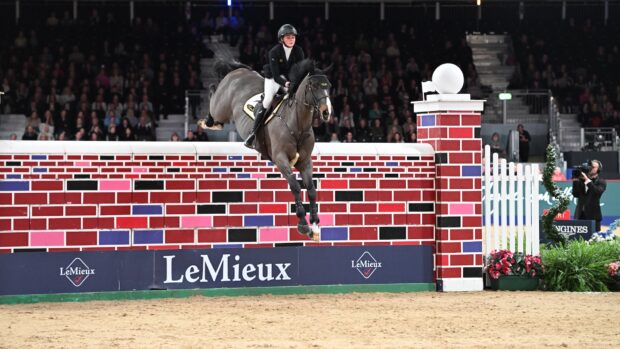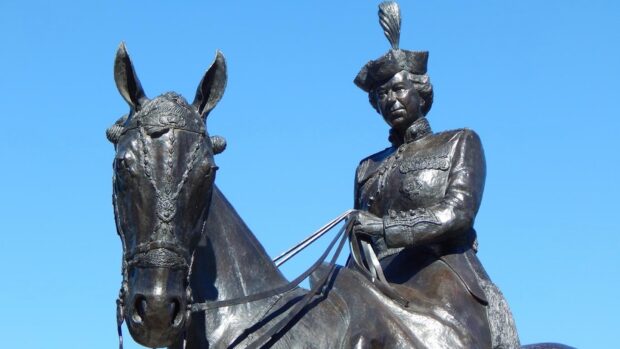Double bridles exert less nasal and rein pressure than snaffles, a study involving top competition horses has found.
Studies comparing the noseband pressure and rein forces exerted by the two types of bridle were among those presented in a session on biomechanics at the British Equine Veterinary Association Congress (12–14 September).
Researcher and biomechanics expert Russell MacKechnie-Guire presented first a summary of a study on noseband pressure.
“You will be aware that the noseband and bridle-horse interaction has received quite widespread attention from both ethical and welfare perspectives,” Dr MacKechnie-Guire said. “Bridle-horse interaction is complex, and that’s really one of the things I want to get across, but unfortunately, they’re often overlooked in training and management of horses.
“There have been concerns raised over the use of double bridles but there’s very little quantitative comparison of the double bridle with the snaffle and we wanted to have a look at the facial pressures and movement symmetries.”
The team recruited 13 horses and riders competing at inter II or grand prix level, accustomed to being ridden in snaffles and doubles, and with their usual riders. All were assessed by a vet, including dentally, to ensure there was no discomfort, and bridle fit was checked.
Pressure was then measured, synchronised with video of the horses moving.
“In this group of horses, we found the mean nasal pressures were lower for the double bridle,” Dr MacKechnie-Guire said. “Maximum nasal pressure was lower for the double bridle versus the snaffle. So in this high-level group of horses, the double bridle did not increase nasal or mandible pressures compared to the snaffle.”
The team did find increased pressure over the horses’ heads in the double, which Dr MacKechnie-Guire said reinforced the complexity of bridle-horse interaction; much attention is given to nosebands but, he said, padding headpieces appropriately would allow distribution of the force.
Dr MacKechnie-Guire also presented a study on rein pressure, on fellow researcher David Marlin’s behalf, conducted at the same time.
This found that in trot, there was less rein force in the double than in the snaffle, and it was similar in walk and canter. The force on the curb bit was less than on the bradoon, in all gaits, and the force on the bradoon was less than on the snaffle.
“What we could potentially suggest is that with the presence of two bits, the total force is being distributed over a greater area,” Dr MacKechnie-Guire said. “It suggests potential for greater focal forces being applied to the oral structures by the snaffle bit.”
Dr MacKechnie-Guire stressed that he was not suggesting all horses should have two bits; he reiterated that these were high-level horses and riders, and future work is needed at lower levels. And on the biological effects of the findings.
Saddle effect
In a separate presentation in the same session, leading biomechanics vet and researcher Rachel Murray looked at changing saddle design and its effect on jumping horses.
The team in this study recruited 14 high-level showjumpers, who were assessed by vets and physios. Ridden by their usual riders, the horses each jumped in a standard monoflap saddle, and one with a lower cantle and different thigh block.
“The only thing that changed was the top, the interface of the rider with the saddle,” Dr Murray said.
Pressures were measured as the horses jumped a 1.20m fence, and it was found that on the approach and landing, there was significantly more pressure in the standard saddle; there was no difference on take-off or the jumping phase.
“So saddle design has the potential to support or restrict rider movement,” Dr Murray said. “Particularly on landing, the rider comes back, hits the back of the saddle and slides down it, whereas, where we don’t have that big cantle, there’s a much smoother interface between the rider and the saddle, and the rider’s pelvis is able to move back further without hitting the saddle.
“We don’t know all the mechanics, but we’ve definitely got a difference in what’s happening with the rider on the two saddles. And what is interesting is that it’s having a difference on the impact of the force between the saddle and the horse.”
Dr Murray again said that this involved high-level horses and riders; taking away support from a less balanced rider may have a negative effect, but it was concluded that “alteration in rider-saddle interaction affects the forces on the horse”.
“Is this a potential protection of the horse’s back?” she said.
- To stay up to date with all the breaking news throughout Horse of the Year Show, London International and more, subscribe to the Horse & Hound website
You may also be interested in:

More movement found in unshod hooves, but study doesn’t claim ‘barefoot is better’

Calls for double bridles to be optional fall on deaf ears – again

‘Not just bits and nosebands’: why bridle fit is so important

Subscribe to Horse & Hound magazine today – and enjoy unlimited website access all year round




